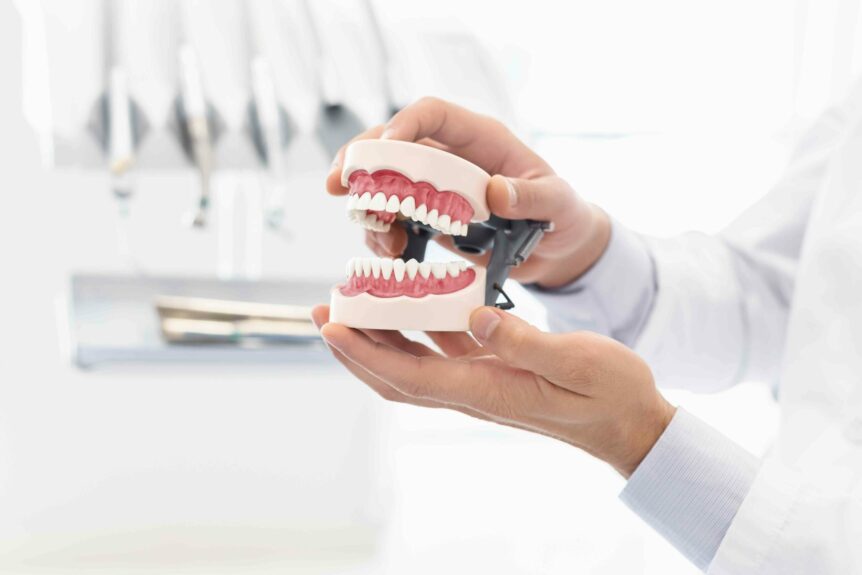Gum and teeth health is extremely important for not only your mouth but the overall health of your body. Although it may seem like an easy task to keep your oral health in tip-top shape, it does take constant care and dedication. The healthier your teeth and gums are, the less risk you have for tooth decay and gum disease.
How Should I Care for My Teeth and Gums?
There are five basic steps to caring for teeth and gums:
- Brushing
- Flossing
- Rinsing
- Eating right
- Visiting the dentist
Tips for Brushing Teeth
Brush at least twice a day. If you can, brush after every meal. Ideally, wait 30 minutes after eating, this will allow any enamel that softened from acid during eating to re-harden and not gets brushed away. Brushing removes plaque, a film of bacteria that clings to teeth. When bacteria in plaque come into contact with food, they produce acids. These acids can then lead to cavities. To brush:
- Place a pea-sized dab of fluoride toothpaste on the head of the toothbrush. (Use a soft toothbrush.)
- Place the toothbrush against the teeth at a 45-degree angle up to the gum line.
- Move the brush across the teeth using a small circular motion. Continue with this motion cleaning one tooth at a time. Keep the tips of the bristles against the gum line. Avoid pressing so hard that the bristles lie flat against the teeth. (Only the tips of the toothbrush clean the teeth.) Let the bristles reach into spaces between teeth.
- Brush across the top of the chewing surfaces of the teeth. Make sure the bristles get into the grooves and crevices.
- Use the same small circular motion to clean the backside of the upper and lower teeth — the side that faces the tongue.
- To clean the inside of the bottom front teeth, angle the head in an up-and-down position toward the bottom inside of the mouth and move the toothbrush in a small circle.
- For the inside of the top front teeth, angle the brush in an up-and-down position with the tip of the head pointing towards the roof of the mouth. Move the toothbrush in a small circle.
- Give your tongue a few gentle brush strokes, brushing from the back of your tongue forward. Do not scrub. This helps remove bacteria and freshens your breath.
- After brushing your teeth for two to three minutes, rinse your mouth with water.
- Replace your toothbrush with a new one every three to four months.
Tips for Flossing Your Teeth
Floss teeth at least once a day. Flossing gets rid of food and plaque between the teeth, where your toothbrush cannot reach. If plaque stays between teeth, it can harden into tartar, which must be removed by a dentist or hygienist. To floss:
- Remove about an 18-inch strip of floss from the dispenser.
- Wind the floss around the middle fingers of each hand, leaving a 1-inch section open for flossing. Floss the top teeth first, then the bottom.
- Place the floss in your mouth and use your index fingers to push the floss between the teeth. Be careful not to push too hard and injure the gums.
- Move the floss up and down against the tooth and up and around the gum line. The floss should form a C-shape around the tooth as you floss.
- Floss between each tooth as well as behind the back teeth.
- Use a clean section of floss as needed and take up used floss by winding it around the fingers.
Tips for Rinsing Your Mouth
Mouthwashes do more than just freshen your breath. Rinse with an antiseptic mouthwash at least once a day to kill bacteria that cause plaque and may help prevent early gum disease. A fluoride rinse can help strengthen teeth and fight against teeth decay and cavities. Some rinses can do both.
- It doesn’t matter if you rinse before or after you brush.
- Swish the mouthwash in your mouth for 30 to 60 seconds.
Visit Your Dentist Regularly
Visit your dentist at least once every six months. To maintain healthy teeth and gums, it’s important to have regular check-ups and professional cleanings. You should also see your dentist if you have pain in your teeth or mouth or bleeding, swollen gums.
You can also ask your dentist about dental sealants. A sealant is a material used to coat the top, chewing surfaces of the teeth. This coating protects the tooth from decay and usually lasts a long time, but can only be placed on a tooth without decay. It is usually placed on children’s teeth as they get their permanent teeth.

